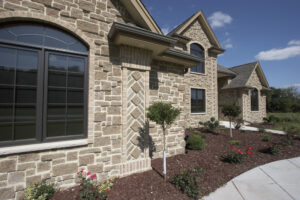Colorado Springs Masonry are crafts that involve the shaping, carving, and fitting of stones to create building structures. It is one of the oldest crafts that humans have been involved in, dating back to when people began arranging rocks to form shelters during the Neolithic Period, 12,000 years ago. It is a skill that requires both art and engineering, as masons must understand how to balance the structural requirements of their project with its aesthetics.
The finished appearance of a masonry structure can be varied through the choice of unit size and shape, mortar color and type, bond pattern, surface treatment, and the location of control joints. For example, the placement of a recessed lighting fixture on a concrete masonry wall may require the use of control joints to relieve horizontal tensile stresses in the wall. These control joints should be located at areas of stress concentration, such as openings or changes in wall height, to minimize their visual impact.
Aesthetic considerations can also be influenced by the choice of a particular stone or material and its availability in a given region. The Mesopotamian civilization used stone and sun-dried bricks, while the Egyptian pyramids showcased a new level of refinement with limestone, alabaster, marble, and granite masonry constructions. The Romans further developed masonry design, creating arches and walls of imposing proportions, and medieval Europe saw the development of a highly refined, intricate style of masonry construction.
Masonry is generally very durable, but like all materials, it can be damaged by environmental attacks. This damage can occur in localized areas due to chemical or biological attack, or it can be global and cause the structural integrity of a structure to degrade. The deterioration of a masonry structure can be accelerated by a number of factors, such as water intrusion and movement of the foundation.
Several options are available for the repair of a damaged masonry structure, including concrete resurfacing (CMU), tuckpointing, or the replacement of individual units of similar size and shape. A well-designed rehabilitation plan will incorporate a combination of these options to restore the structure to its original condition.
Strength
Masonry is a type of construction that involves the use of bricks. These bricks are bonded together with mortar. It is a time-honored building material and is still used in some buildings today. Masonry is an ancient art that requires a high level of skill to build. It is also an extremely durable material. Masons are trained through apprenticeships with more experienced masons.
The strength of masonry is dependent on several factors, including the type of blocks used and the type of mortar. It is important to understand these factors when designing a structure. A good understanding of the strength of masonry can help engineers design structures that are both safe and cost-effective.
When it comes to testing the strength of masonry, there are many different methods that can be used. Some are more destructive than others, but they can provide a good idea of the strength of the material. These tests include flexure and shear testing. Flexure testing measures the amount of stress a wall can withstand under bending. Shear testing, on the other hand, measures how much pressure a wall can take under compression.
It is important to note that a masonry wall’s compressive strength is determined by the assemblage of its brick units, mortar, and grout. Therefore, it is important to consider the effect of these variables when comparing experimental values with prediction formulas. A number of studies have been conducted to compare experimental values with available prediction formulas. Drougkas [43] reviewed literature data and tested various formulas, including the Hilsdorf model. However, he did not test several of the key inputs into the model, such as the grout area and the bending moment at the head joints.
A simple model for predicting the compressive strength of a concrete masonry unit is to divide the maximum load by its cross-sectional area. This method can be applied to a wide range of block types, including concrete, hollow, and solid blocks. It is particularly useful for assessing the strength of heterogeneous blended masonry. This method can be used for evaluating local failures of existing walls or to estimate their capacity after exceptional events, such as earthquakes or floods.
Durability
Masonry is a durable form of construction that can stand up to all kinds of weather. Brick or stone walls are thicker than wood, and they can keep cold air out during the winter and hot air in during the summer. This means that you can save money on your heating and cooling bills. In addition, masonry is also resistant to fire. This can protect your valuables and your family from fire damage. It can even protect your business from fire damage if it is a large structure.
Masonry construction uses basic building units such as bricks, stones, marbles, granites, pre-cast hollow blocks, clay bricks, and concrete blocks that are bonded with a binder to build walls or other structural elements. The binder can be lime, cement, dirt, or another material. The quality and workmanship of the mortar and the pattern in which the building units are assembled determine a masonry construction’s durability.
Brick masonry is one of the most popular and versatile types of masonry. It is a very durable and attractive choice for homeowners who want to add character to their property. It is also a cost-effective alternative to other materials, as it is relatively easy to work with. However, it’s important to hire a mason who has experience with this type of construction.
Another benefit of masonry is that it provides good insulation for homes and businesses. It can reduce energy costs by keeping cool air in during the summer and warm air in during the winter. It can also protect your belongings from pests like termites and other wood-destroying insects.
In terms of durability, masonry structures can withstand many natural disasters, including hurricanes, tornadoes, and earthquakes. However, they can be less stable in areas prone to earthquakes because the walls rely on their weight for support rather than being reinforced with steel. They are also much heavier than other types of buildings and can lead to structural problems if they’re not constructed properly. It’s important to consider these risks before choosing masonry construction for your next project.
Fire resistance
Masonry’s inherent fire resistance, when properly incorporated into a building’s design and construction, offers protection to occupants and to the structure during its service life. In addition, masonry walls are critical to a building’s fire safety, providing strategic compartmentation of the occupants and ensuring that noxious gases and fire are contained and firefighters can operate safely within the structure.
Masonry fire walls are designed to meet today’s stringent code requirements and performance standards. These walls isolate and contain the fire, noxious gases, and smoke while retaining structural integrity to ensure safe evacuation and support for firefighters.
The fire-resistance rating of a concrete or clay masonry wall is determined by the equivalent thickness (E) of the masonry assembly, calculated in accordance with the following equation:
For a solid, grouted masonry unit, the E value is equal to the actual thickness. This formula also applies for hollow units with the cores filled with a noncombustible material or, in the case of partially grouted walls, to those masonry units where the unfilled cells are filled with an approved material.
The E value of a wall with finishes applied is determined by multiplying the finish thickness (T) by the factor given in Table 7. This is then added to the E value of the concrete or clay masonry to determine its fire-resistance rating.
In addition to the E values, fire-resistance ratings for masonry walls are also established by conducting standard fire tests. These tests primarily examine the thermal and structural behavior of masonry walls as they experience the effects of standard fires.
